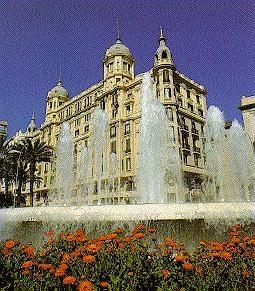

Castillo de Santa Bárbara (Santa Bárbara Castle) This is the most emblematic construction in the city, located on the summit of mount Benacantil at 166m above the nearby sea. Archeological findings seem to indicate that this was a site of an Iberian hill fort. Today the majority of the castle dates from the 16th century. Of note are the Torre del Homenaje (keep), the Baluarte de los Ingleses (the Englishmen's bastion), la Capilla de Santa Bárbara, el Salón de Felipe II and others. The ascent can be made either by car or via a lift going up from the Postiguet beach. Visiting is a must, because the bastions provide a splendid panorama of the city and the coast. From here you will see the island of Tabarca, located off the coast from Cape Aljub near Santa Pola.
Iglesia de Santa Maria (Church of St. Mary) This 16th-century church was built on the site of an ancient Arab mosque. It has a gothic interior, and baroque high altar and doorway.
Concatedral de San Nicolás de Bari (Cathedral Church of St. Nicholas of Bari) Finished in 1662, this church in renaissance style with baroque elements in the altar and communion chapel is considered as one of the best examples of Spain's high baroque. Of special interest is the cloister, adorned with grilles and wooden doors.
Ayuntamiento (City Hall) A fine example of baroque civil architecture finished in 1760. On the first step of the stairway on the first floor is a small metal disc indicating sea level, used as a reference point for measuring height above sea level for all other points in Spain.
Monasterio de la Santa Faz (Monastery of the Holy Face) Located in the village district of the same name eight kilometres north of the City along the Alicante-Valencia route, this church was terminated in 1766 in renaissance style, with a baroque doorway. In a side-chapel of the church there is a reliquary containing one of the folds of linen used by Veronica to wipe Christ's brow during the Calvary. This relic was brought from Rome in the 1 5th century. Abutting onto the building is a fortified tower from the 16th century.
Castillo de San Fernando (Castle of St. Ferdinand) This is located on the Tossal hilltop, and is now completely dismantled, although it is true to say that this fortress was never terminated, as it was begun just before the French invasion. The spacious platform it now offers is used for sports and leisure activities.
Palacio Gravina (Gravina Palace) Constructed in the 18th century, this building now contains the provincial Archives, governed by the provincial Council. Exhibitions and cultural activites are often staged here.
Isla de Tabarca (Island of Tabarca) This island is in fact a natural monument, and is the only inhabited island in the land of Valencia, an erstwhile refuge of pirates and corsairs, now pertaining to the municipality of Alicante. It is eleven nautical miles from Alicante and three from Santa Pola. The waters around the island are now listed as a Marine Reserve. The island has an important set of fortifications (walls, bastion and doorways), an 18th century church and the castle of San José. Tabarca was declared a Historical-Artistic Monument in 1964.